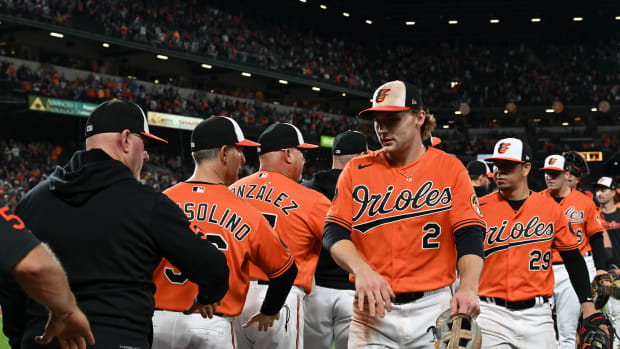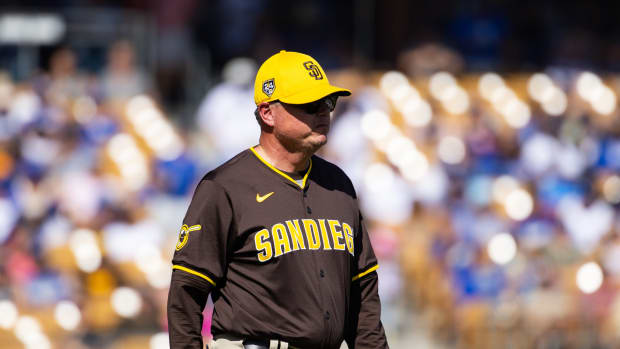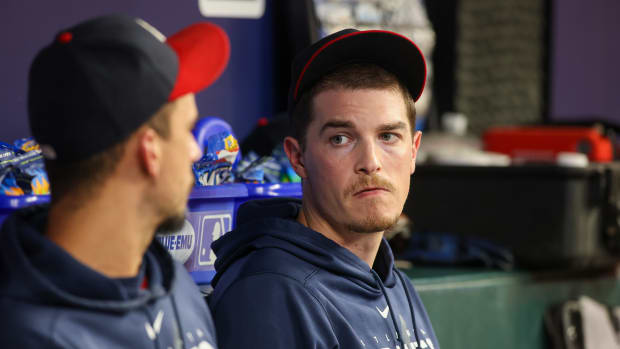The Astros and Dodgers Have Forever Changed Baseball With an Unforgettable World Series
Somewhere between the mammoth retractable roof, the ginormous train rolling on tracks 200 feet off the ground, the battalions of overworked, buy-‘em-in bulk, long-whiskered relievers, the curiously lively and slick baseballs, the data provided by Harvard PhDs to help a manager run a game, the color-coded, pocket-sized laminated cards that tell outfielders where to stand, the paranoia-driven mound quorums, and above it all the constant shelling of home runs, not all of which actually required two hands on the bat, the World Series became an extravaganza, a term 18th century Italians came up with to define over the top. On the spectrum of spectacles, October baseball this year moved farther from Sandy Koufax and closer to Lady Gaga, two famous lefthanders of differing aesthetics who attended Game 1 at Dodger Stadium in Los Angeles.
The Dodgers and Houston Astros played a brand of baseball that didn’t exist three years ago, never mind back in Koufax’s humble day of long shadows and short games. It was as if they took every major trend in the game these days, chucked them in a blender and hit puree. Out spilled a concoction that thrilled in ways never before seen or imagined in a World Series.
“I haven’t seen a whole lot of World Series,” said Kiké Hernandez, a 26-year-old infielder/outfielder for the Dodgers, as he walked toward one of his team’s three buses at the absurd baseball hour of 1:30 Monday morning after Game 5 at Minute Maid Park in Houston. “But this has to be the craziest series ever. Two juggernauts going at it. This has to be one of the best ever.”
And Hernandez’s team lost Game 5, a baseball burlesque that would have made Gaga blush. The Astros overcame three leads and blew one of their own before finally prevailing in 10 innings, 13–12, in a game that required five hours, 17 minutes. It was a Busby Berkeley production that put Houston one win away from its first world championship in the franchise’s 55-year history.
Dodgers Fall on Wrong End of Classic World Series Game 5, Face Elimination as Series Shifts to L.A.
Consider it an original score: it was the first time any of the 1,542 postseason games ever played ended 13–12.
In five World Series games the Dodgers and Astros combined to use 51 pitchers while trying to stem what still amounted to 22 homers, equaling the record set in the 2002 World Series, the last one before steroid testing. They hit more homers in five games than the 2012, 2013 and 2014 World Series put together. Homers flew out at a rate of one every 15.8 at-bats, essentially turning everybody into Willie McCovey, and a 42% increase over a regular season that produced a record bounty of 6,105 homers, or roughly 463 miles worth of dingers.
Someday, Dodgers pitcher Clayton Kershaw will have to try to explain this extravaganza to his son, Charley. For now, though, Charley is just 11 1/2 months old, and after Game 5 was more than content with the far simpler things in life: a pacifier and a cozy place in his father’s arms at the front of the caravan of Dodgers’ buses. His dad, the Koufax of our generation, actually started the 13–12 vaudeville act against another former Cy Young Award winner, Dallas Keuchel, making the night all the more bizarre.
“This is the game that they wanted,” Kershaw said of the seven-homer slugfest, “so this is the game we got.”
Kershaw was gone before the fifth inning ended. With 39 sliders, Kershaw obtained only one swing and miss—his lowest whiff count on the pitch in his past 134 starts. His troubles with the slider echoed those of Dodgers Game 3 starter Yu Darvish (zero swings and misses on his slider for the first time in 34 starts this year) and Astros Game 2 starter Justin Verlander (one swing and miss on the pitch for the first time in 36 starts this year of more than two innings), both of whom told SI that the unusual slickness of the World Series ball made throwing the pitch difficult, a claim supported by both pitching coaches, Brent Strom of the Astros and Rick Honeycutt of the Dodgers. (MLB officials denied any change to the ball other than the ink color.)
Historic World Series Home Run Rate may be Result of Slicker Baseballs
When asked if the World Series baseball caused him trouble throwing the slider, Kershaw gave a wry grin, shrugged, and said, “It’s the same for both teams.”
So preposterous was Game 5 that Houston outfielder George Springer could think of only one thing to say to Dodgers first baseman Cody Bellinger after drawing a walk in the 10th inning: “I need a sandwich.”
On the next pitch, the 417th of the night, facing Dodgers closer Kenley Jansen, Alex Bregman swatted a single into leftfield that chased home pinch-runner Derek Fisher from second base with the 25th and deliriously deciding run.
How did we get here? How could it be that only three years ago, in the pits of an offensive downturn, the major league rate of home runs was the lowest since 1992 and the batting average was the worst since the DH was added in 1973? Verlander fished around his locker for an answer and found it: a printout that showed the probability of home runs in 2014 and 2017 based on the same two variables: the launch angle and exit velocity off the bat.
“Look, a ball hit 97 mph with this launch angle is much more likely to be a home run this year than it was three years ago,” Verlander said. “In other words, a ball hit the same exact way is much more likely to be a home run now than it was in 2014. What changed? The variables are the same. Only the ball changed.”
Home runs spiked suddenly in the final two months of the 2015 season, and have continued to surge. Around the same time, the analytics movement in baseball matured and became so widespread that it began to change how baseball is played, not just delineated. In the fourth round in 2013, for instance, the Dodgers drafted Bellinger, a first baseman/outfielder from Hamilton High School in Chandler, Ariz., with a flat, line-drive stroke. He hit one home run his senior year. “And that one bounced on the top of the fence and over,” he said.
Bellinger hit four home runs combined in his first two pro seasons, after which the Dodgers assigned him to work with Shawn Wooten, an organizational hitting instructor. Wooten told Bellinger he had to hit the ball in the air, not on the ground, and changed his swing to create more loft. Bellinger promptly hit 30 homers in A ball the next year, and a National League rookie record 39 this year. (He also whiffed 146 times.)
Hitters old and young began changing their swing to get more loft. Dodgers third baseman Justin Turner overhauled his stroke after the 2013 season, and transformed from a guy the Mets cut to one the Dodgers will pay $71 million over seven years. Los Angeles outfielder Chris Taylor, upon being left off the team’s postseason roster last year, reported to Dodgers hitting consultants Craig Wallenbrock and Robert Van Scoyoc in Arizona to overhaul his swing. After hitting one career homer, Taylor hit 21 this year. The Astros, upon drafting Bregman with the second overall pick in 2015, told him his days of hitting groundballs were over, and tweaked his stroke to get more balls airborne.
“Nobody wants to hit the ball on the ground any more,” said Dodgers manager Dave Roberts. “Especially with the shift now, you hit the ball on the ground in the big leagues, you’re out.”
You know analytics have arrived when laminating becomes a required skill for coaches. Before each World Series game Dodgers first base and outfield coach George Lombard would print sheets of paper with positioning charts for his outfielders, cut them out, then run them through a laminator. Each card tells each outfielder where to play opposing hitters, a system Los Angeles used during the regular season, but in the postseason took a step further by tailoring them for each Dodger pitcher. Each time the team would change pitchers mid-inning, a ball boy would grab new cards from Lombard and run to the outfielders to distribute them.
After a Game 5 for the History Books, the Astros and Dodgers Wonder About Those Slick Baseballs
Welcome to the World Series of analytics. Not only did this World Series pit two 100-plus-win teams against one another for the first time in the free agent era (the last such matchup was 1970), but also two of the most advanced analytical teams. The Dodgers, for instance, employ a Senior Analyst in Research and Development, Dan Cervone, who studied math and statistics at the University of Chicago, interned at Google, earned a PhD in statistics at Harvard, served a fellowship at NYU, and turned down offers from hedge funds to crunch baseball stats, or more accurately, according to his web site, focus on “spatiotemporal data and hierarchal models, with particular application to sports analytics and player tracking data.”
For their part, the Astros have been at the forefront of using spin rates to sign pitchers (Collin McHugh, Charlie Morton), of using data to increase their usage of breaking balls, and of using technology as development tools.
Verlander, for instance, upon being traded Aug. 31 from Detroit to Houston, prospered from the use of a high-speed video camera the Astros use to film bullpen sessions. (The Tigers did not have one.) Houston won all 10 games Verlander pitched for them heading into a Game 6 start in Los Angeles, including a wild 7–6, 11-inning victory in Game 2, the prequel to Houston’s epic Game 5 win.
“If we’re in a slugfest, my money is on this team,” Bregman said. “We bang. We’re the best hitting team in baseball. Their bullpen is really good, and I don’t want to sound like a [jerk], but our offense is really good and we’ll go toe-to-toe with anyone and win.”
Meanwhile, during the series, the rest of baseball was trying to close ground on Los Angeles and Houston as state-of-the-art leaders. Three playoff teams fired veteran managers—Joe Girardi, 53, by the Yankees, John Farrell, 55, by the Red Sox and Dusty Baker, 68, by the Nationals—and searched for their own version of World Series managers and good friends Roberts, 45, and A.J. Hinch, 42: a youthful, perhaps even rookie manager who connects with young players and is fluent in analytics. The game has changed so much in a short time that experience has lost its cachet.
The Red Sox hired Houston bench coach Alex Cora, 42, and the Nationals hired Cubs bench coach Dave Martinez, 53, neither of who managed previously. The Yankees had not found their Roberts yet, but they did send an email to University of Chicago masters students looking for a quantitative analyst associate and summer intern to work on “projects related to player evaluation, player development, and/or in-game strategy.”
The World Series proved how much the quants are driving in-game strategy. As teams emphasize using more bullpen arms to pick up a bigger chunks of games, this world champion will have pulled its starters after five innings or less in the regular season more than any other champ, whether it’s the Dodgers (76) or Astros (61). Such strategy had worked fine for Los Angeles, which had been 93–0 with a lead entering the ninth inning, until Roberts pulled starter Rich Hill after four innings in Game 2, starting a bullpen cascade that ended with a rusty Brandon McCarthy taking the loss.
The It Takes a Village school of bullpen management took a firmer hit in Game 5, always a dicey game because it’s the only time in a World Series when clubs play for a third straight day. By then, relievers for the Dodgers and Astros were either overworked, overexposed or both.
The risk never was more obvious than when Roberts, after saying before the game he wasn’t going to use Brandon Morrow, plugged Morrow into the seventh inning with an 8–7 lead. Morrow had called the dugout from the bullpen to say he felt well enough to pitch for the 12th time in the past 13 games. The Astros scored four times on four vicious swings on Morrow’s first six pitches: a home run by George Springer, a single by Bregman, a double by Jose Altuve and a home run by Carlos Correa.
“I don’t know how many times I’ve said ‘This is the craziest game of my life’ in the past couple of weeks,” said winning pitcher Joe Musgrove, the only one among 14 pitchers in the game who managed to get at least three outs without giving up a run. He also was one of the 11 bearded pitchers among the 14, adding to the Comic Con nature of the spectacular. “But now this is the craziest game of my life.”
Only one World Series game saw more runners cross home plate: a 15–14 win for Toronto in Philadelphia in Game 4 of the 1993 World Series. That game included only three home runs, and mostly featured singles (20 of them) skittering across a wet artificial surface field. This game included 11 singles, and 14 balls that smacked off or over the outfield wall.
That game was an anomaly; this game was a signature. In just three years baseball added 1,919 home runs and 1,198 pitching changes. The great sweep of rapid change—the swing paths, the data-driven decision-making, the parade of relievers, the consequences of when a livelier ball gets airborne—vacuum-packed itself into one World Series. The sheer density of it all was extravagant.




































